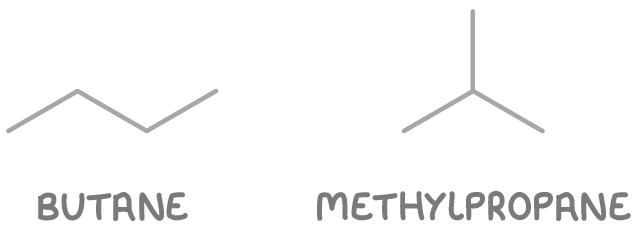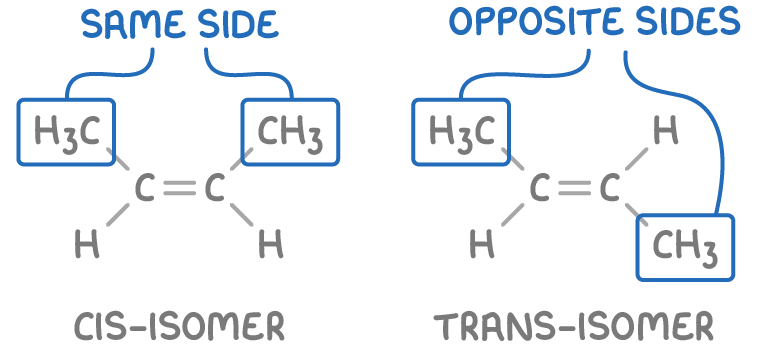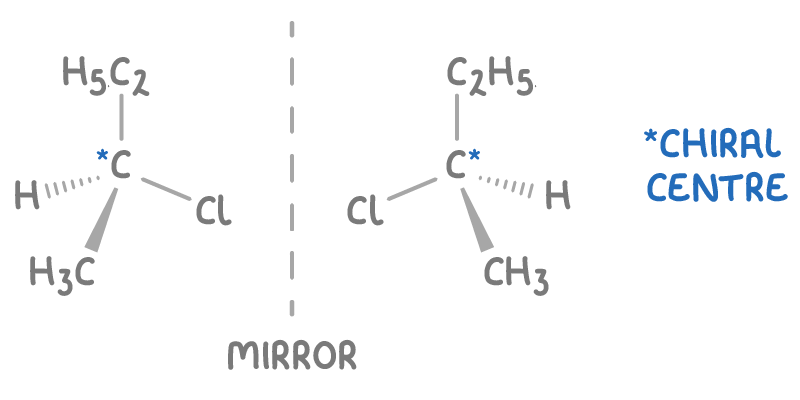Isomerism
This lesson covers:
- Structural isomers and stereoisomers
- The three types of structural isomer: chain, positional, and functional group
- The two types of stereoisomer: geometric and optical
- How to identify structural isomers and stereoisomers
- cis-trans system for naming stereoisomers
Types of isomerism
Isomers are molecules with the same molecular formula but different arrangements of atoms.
They fall into two main categories:
- Structural isomers - These molecules have the same atoms but different connections.
- Stereoisomers - These molecules are connected in the same way but have different spatial arrangements of atoms.
Structural isomers
Structural isomers are divided into three sub-types:
- Chain isomers - Differ in the carbon skeleton arrangement (e.g., straight chain vs branched chain).
- Positional isomers - The functional group is attached at different carbon atoms.
- Functional group isomers - The atoms form different functional groups.
Worked example 1 - Identifying chain isomers in butane
Determine the possible chain isomers of butane.
Step 1: Identify the molecular formula
Butane has the molecular formula C4H10.
Step 2: Determine possible structures
- Butane - A straight chain of four carbon atoms.
- Methylpropane - A branched chain with three carbon atoms in the main chain and one methyl group branching off.

So there are two chain isomers of C4H10: butane and methylpropane.
Worked example 2 - Identifying positional isomers of chloropentane
Determine the positional isomers of chloropentane.
Step 1: Identify the molecular formula
Chloropentane has the molecular formula C5H11Cl.
Step 2: Determine possible structures
- 1-chloropentane - Chlorine on the first carbon.
- 2-chloropentane - Chlorine on the second carbon.
- 3-chloropentane - Chlorine on the third carbon.

So there are three positional isomers of chloropentane: 1-chloropentane, 2-chloropentane, and 3-chloropentane.
Note: 4-chloropentane and 5-chloropentane mirror 2-chloropentane and 1-chloropentane due to the symmetry of the pentane chain, so they aren't distinct isomers.
Worked example 3 - Identifying functional group isomers of C3H6O
Determine the functional group isomers for C3H6O.
Step 1: Identify functional groups and carbon skeleton
C3H6O can form different functional groups like aldehydes or ketones.
Step 2: Determine possible structures
- Propanal - An aldehyde at the end of a three-carbon chain.
- Propanone - A ketone in the middle of a three-carbon chain.

So C3H6O has two functional group isomers: propanal, and propanone.
Stereoisomers
Stereoisomers are categorised into two sub-types:
- Geometric (cis-trans) isomers
- Optical isomers
Geometric (cis-trans) isomers
Cis-trans isomerism can occur in straight-chain alkenes when the carbon-carbon double bond restricts rotation. This leads to two configurations:
- Cis configuration - The substituent groups are positioned on the same side of the carbon-carbon double bond.
- Trans configuration - The substituent groups are positioned across from one another, on opposite sides of the carbon-carbon double bond.

For example, in cis-but-2-ene, the methyl groups are positioned above the same side of the double bond whereas in trans-but-2-ene, the methyl groups are positioned diagonally across the double bond from one another.
Optical isomers
Optical isomers form when a molecule contains a chiral centre - a carbon atom bonded to four different substituents, creating non-superimposable mirror image forms, or enantiomers.
For instance, 2-chlorobutane has a chiral centre on its second carbon, bonded to a chlorine atom, a methyl group, an ethyl group, and a hydrogen atom, resulting in two mirror image forms.

These enantiomers, though structurally identical, show different interactions with plane-polarised light.